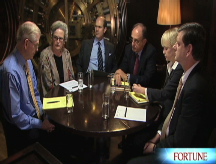U.S. deficit climbs to $402 billion
The budget gap racked up in first two months of the fiscal year approaches the level recorded for all of '08.

NEW YORK (CNNMoney.com) -- The Treasury Department on Wednesday reported that $164.4 billion was added to the federal budget deficit in November -- bringing the total deficit for the first two months of the fiscal year to $401.6 billion.
By comparison, the budget deficit for all of fiscal year 2008 was $455 billion, according to the Treasury.
Two key reasons for the steep deficit increase: the financial stabilization efforts undertaken by Treasury this fall and a decline in tax receipts.
Budget experts have projected that the federal deficit for this fiscal year, which began Oct. 1, will approach $1 trillion. But that number doesn't count the effects of an economic recovery package that Congress is expected to pass early next year.
That package is expected to commit between $500 billion and $700 billion to stimulate economic activity. If it succeeds, the effect on the budget deficit is likely to be less than the upfront cost.
Both liberal and conservative economists have said that, given the magnitude of the economic downturn, policies that increase the deficit now are less of problematic than letting the economy deteriorate further.
Even leading deficit hawk Robert Bixby, executive director of the Concord Coalition, says it's understandable if the government runs up the deficit in the short term.
"There's a very deep recession and a financial crisis. ... It's not good in the long term to let markets crash and companies go bankrupt," Bixby said. But, he cautioned, " We can't keep running trillion dollar deficits for the next few years."
That's why, he said, "it's a real problem if lawmakers use a short-term crisis to make long-term commitments" such a permanent tax cuts and expanding entitlement programs such as Medicare.
Treasury's deficit numbers are higher than estimates from the Congressional Budget Office (CBO), which is charged with scoring the cost of legislation and tallying the country's deficit and surplus levels for lawmakers' consideration.
The reason for the difference in part is the different way in which each agency accounts for money committed under the $700 billion financial rescue package - or the Troubled Asset Relief Program (TARP).
The CBO calculates the potential deficit effects of TARP money using a net present value basis - meaning it assumes some of the money put out will return to the Treasury because it is money invested. The Treasury, by contrast, uses a cash-basis assumption, which does not account for a return on investment.
The Treasury reports that in the first two months of the fiscal year it committed outlays of $191.5 billion under the TARP and $13.8 billion on housing and economic recovery programs. There are no comparable outlays during the first two months of last year.
The Treasury also paid nearly $32 billion on its outstanding debt, but that was down from nearly $48 billion paid during the same period a year ago, reflecting the dramatic drop in interest rates.
Indeed, while the Treasury adds to the deficit whenever it issues bonds, of late such debt issuance has come mighty cheap. On Tuesday, the Treasury auctioned $30 billion worth of 28-day bills at 0%. ![]()



